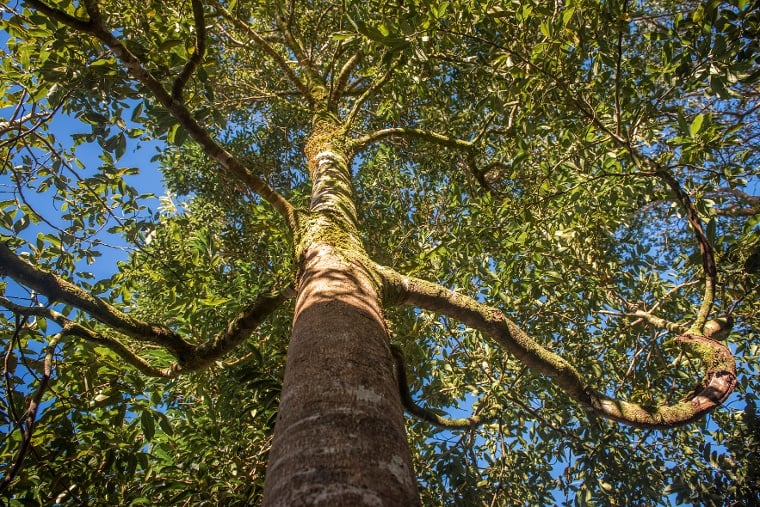Everything About the Resplendent Quetzal

Today’s post is about one of Costa Rica’s most iconic and sought-after creatures. With its stunningly iridescent plumage and long curling tail feathers, the Resplendent Quetzal is a bird watcher's delight. It is also widely considered to be the most beautiful bird in the world.
While they are technically Guatemala’s National bird, these beauties have become almost synonymous with Costa Rica due to the high-altitude areas where they live. It’s also because, while they are nearing the endangered list, Costa Rica’s many protected areas provide Quetzals more of what they need to thrive.
Birders understand that if they want a better chance of spotting a Resplendent Quetzal - their best bet is to visit the reserves of Monteverde. Monteverde, in turn, is doing its best to protect and support this colorful bird, by working hard to preserve their favorite food source- the Ocotea tree. (For more information on the Ocotea tree, click here) For that reason, the Costa Rican Quetzal population (of which there are 50,000) is stronger than anywhere else in Central America.
Interesting facts About the Quetzal
-
Believe it or not, the Resplendent Quetzal is actually brown! The iridescent green color that we see is actually caused by stripes of melanin that catch the light, trapping most of the colors but reflecting the green back to our eyes. It is similar to what happens with the beautiful blue Morpho butterflies which are also native to Costa Rica.
-
The best time to spot a Quetzal is during breeding season which ranges from February to July. This actually coincides with when the Ocotea trees are producing fruit.
-
Pairs generally produce 1 or 2 blue eggs and share the incubation responsibilities. They must rear their offspring in tree holes that were created by woodpeckers and toucans because their beaks aren’t strong enough to dig their own holes. The scarcity of proper nesting locations is part of the reason for the decline of the Quetzal population.
-
The tail feathers of the male can grow up to 1 meter long!
-
They are omnivorous, supplementing fruits and berries with insects, frogs, lizards, and snails that they catch.
-
They aren’t very good flyers and move from tree to tree by hopping, which makes them targets for owls, hawks, and other predators.
-
Over the course of their 25-year lifespan, they can grow to be 7-8 oz and have a height of 11-15.6 inches.
-
The Resplendent is one of 6 sub-species of the Quetzal, also known as Trogo.

Spotting a Resplendent Quetzal
While they are famous for the brilliant green of their plumage, the Quetzal can also be spotted by the male’s vibrant red chest feathers and golden green head crest.
Females have a duller color and shorter tails, with grey breast and belly feathers and a green-bronze head crest which allows them to better blend into their surroundings as camouflage from predators.
The best place to spot them (during the mating/nesting season) is at the Monteverde Cloud Forest Reserve. Since their territory is only a few hundred meters across, once the birds begin to nest, local birders and conservationists mark their locations and count their numbers.
By hiring a local guide, you give yourself the best chance to find one, and the long didscopes that they carry with them will allow you some amazing shots for your collection. The following link will take you to a YouTube Video that features the call made by the Resplendent Quetzal.

The Resplendent Quetzal’s Place in Costa Rican Culture
In terms of indigenous culture, the northern parts of what is now Costa Rica were highly influenced by Mayan, Ormec, Incan, and Aztec cultures, (in that order). These civilizations stretched from parts of Central Mexico all the way through to present-day Central America as well as holding territory in South America, Southern Colombia, and Southern Chile.
While there are significant differences between these cultures, they all revered the Resplendent Quetzal, believing that only the Gods could create such a magnificent creature. In fact, the word quetzal is carried through several Mesoamerican languages and means “precious” or “sacred.”
It is closely associated with the snake god Quetzalcoatl (also known as Kukulcan) which is visually represented as a serpent adorned with the feathers of the quetzal. In both Mayan and Aztec cultures, Quetzalcoatl is seen as a symbol of light and goodness.

While the bird’s impressive tail feathers were highly prized and often used to decorate the rulers' magnificent headdresses, the penalty for killing a Quetzal was death.
According to one Guatemalan legend says that during a battle between Tecún Umán, a prince and warrior of the Quiché Maya, and the Spanish conquistador Pedro de Alvarado, there was a quetzal flying overhead. The prince was able to disarm Alvarado on his first strike but was killed on the second strike by a spear that penetrated his chest.
According to the legend, a quetzal flew down to Tecún Umán and dipped his feathered chest in the brave prince's blood, which is how the species acquired their red breast feathers.
Another Mayan tale states that the quetzal was once known for its beautiful song, but after the Spanish conquered the land, it vowed not to sing again until the land was free once more.
Saving the Resplendent Quetzal
Thanks to the efforts of researchers, educators, and conservationists alike, there are programs underway designed to support the flagging Quetzal population. Many of these programs are at least partially funded by eco-conscious tourists who not only donate to these programs but physically travel to Monteverde and hike the reserves, camera in hand, hoping for a fleeting glimpse of a bird whose beauty has inspired mankind for thousands of years.
One of these programs was mentioned earlier in the post. “Mi Ocotea” was started by the Monteverde Institute back in 2020 to push for the conservation of the all-important Ocotea Monteverdensis tree.

The Quetzal Education Research Center in San Gerardo de Dota connects students and researchers from around the world with conservationists and educators who share their knowledge and teach students in the fields of biodiversity, conservation, and sustainable practices.
They do this in the belief that if we all work together for a better future, we can combine good conservation practices with economic viability for the community. Because when communities are strong- they can accomplish anything.
Courses offered by the QERC include Tropical Ecology and Sustainability, Tropical Field Research, tropical Medicine, Central American History and Culture, and More.
Another factor that may assist the Quetzal population is that local conservationists at the Quetzal conservation program of the Monteverde Cloud Forest Reserve have successfully introduced artificial nests into the area which have been successfully accepted by nesting Quetzals.
The Bottom Line
When it comes right down to it, every species has a part to play in the health of our planet’s many ecosystems, but we can’t help but have a soft spot for the colorful Resplendent Quetzal with its majestically long tail feathers, haunting call, and magically iridescent wings. We hope that by sharing the plight of this and so many other endangered species, we can garner the support of people around the world to protect this mythic bird.
As always, if you would like to come and explore the wonders of Monteverde, we hope you will do us the honor of helping you in any way that we can. Just click here to take the first step to your next Monteverde adventure.





